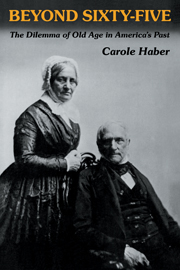Book contents
- Frontmatter
- Contents
- List of Tables
- Acknowledgments
- INTRODUCTION: Classifying Society's Superannuated
- CHAPTER ONE Aging in Colonial America
- CHAPTER TWO Social Realities and Perceptions of Old Age in the Nineteenth Century
- CHAPTER THREE Medical Models of Growing Old
- CHAPTER FOUR Treating the Postclimacteric Stage
- CHAPTER FIVE Institutionalizing the Elderly
- CHAPTER SIX The Pension Barrier
- CONCLUSION: Old Age in a Bureaucratic Society
- Notes
- A Note on Secondary Sources
- Index
CONCLUSION: Old Age in a Bureaucratic Society
Published online by Cambridge University Press: 26 February 2010
- Frontmatter
- Contents
- List of Tables
- Acknowledgments
- INTRODUCTION: Classifying Society's Superannuated
- CHAPTER ONE Aging in Colonial America
- CHAPTER TWO Social Realities and Perceptions of Old Age in the Nineteenth Century
- CHAPTER THREE Medical Models of Growing Old
- CHAPTER FOUR Treating the Postclimacteric Stage
- CHAPTER FIVE Institutionalizing the Elderly
- CHAPTER SIX The Pension Barrier
- CONCLUSION: Old Age in a Bureaucratic Society
- Notes
- A Note on Secondary Sources
- Index
Summary
By the beginning of the twentieth century, the segregation of the aged had begun to assume institutional form. In the policies and asylums designed for the old, the last years of life were secluded from the turmoil of the industrial world. Beyond sixty-five, an individual was naturally thought to be antiquated; his age alone became clear proof of his superannuated state.
This conception has had a distinctive history, evolving with the nation's urban and industrial development. Even in colonial times, of course, certain people had been characterized as useless and overaged. Their many years brought ridicule and shame; they received little of the biblically prescribed respect. But such judgments were individual and functional, not categorical. They were based on the clear inability of these persons to retain any valued resource.
Throughout the nineteenth century, this class of aged persons continued to exist, and, it seemed, in ever-increasing numbers. As the economic organization of society changed, a significant proportion of the old could not depend on the land to assure their status. As the life cycle was transformed, they were no longer guaranteed an important position within the nuclear family. Loss of parental authority, of occupation, and of wealth all defined the existence of the overaged.
The plight of these individuals then became the subject of wide professional concern. Beginning in the mid-nineteenth century, scores of charity workers, social theorists, doctors, and businessmen focused upon the unique problems of the senescent. The writings of these experts reflected the popular belief that in industrial society most aged persons could be considered to have little purpose.
- Type
- Chapter
- Information
- Beyond Sixty-FiveThe Dilemma of Old Age in America's Past, pp. 125 - 129Publisher: Cambridge University PressPrint publication year: 1983

